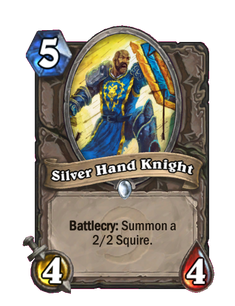THIS IS THE OLD WIKI. There will be outdated information. See this page in the new wiki
- You might be looking for one of these cards: Squire (Classic).
Squire is an uncollectible neutral minion card, from the Legacy set.
Other versions
Related with
Sounds
- Play
- ▶️
VO_CS2_152_Play_01.wavReady, sir.
- Attack
- ▶️
VO_CS2_152_Attack_02.wavAh...if you insist.
- Death
- ▶️
VO_CS2_152_Death_03.wav<death sound>
Lore
A squire is typically a boy from ages 10–18 that acts as a servant to a knight learning about chivalry, combat, politics, warfare and more. There is nothing special about this squire card, because there is usually nothing special about squires in general. They are in fact quite expendable. From Wikipedia
- A squire was the shield bearer or armour bearer of a knight, and at times squires included a knight's errand runner or servant. Use of the term has evolved over time. In the Middle Ages, squires were trainees to a knight but later a leader in an English village or Lord of the Manor might be called a squire, and later key public figures such as justice of the peace or Member of Parliament. In contemporary American usage as well, squire is the title given to Justice of the peace or similar local dignitaries.
- Squire is a shortened version of the word Esquire, from the Old French escuier (modern French écuyer), itself derived from the Late Latin scutarius ("shield bearer"), in medieval or Old English a scutifer. The Classical Latin equivalent was armiger, "arms bearer".
- The most common definition of 'squire' is that to which refers to the medieval times. A squire would be a teenage boy, in his training to become a knight. A boy became a squire at the age of 14. This was the second stage to becoming a knight, after serving first as a page. As part of his development to that end, he served an existing knight as an attendant or shield carrier, doing simple but important tasks like saddling a horse or caring for the knight's weapons and armour. The squire would sometimes carry the knight's flag to battle with his master.
- But a squire did not stay a squire forever. A knight would take his squires (a knight could have multiple squires but a squire could only have one knight) into battle with him and that was a squire's chance to prove himself. If he proved his loyalty and skill in battle, he would have a dubbing, an official ceremony to become a knight. However, during the Middle Ages the rank of the squire came to be recognized in its own right, and once knighthood ceased to be conferred by any but the monarch, it was no longer to be assumed that a squire would in due course progress to be a knight. The connection between a squire and any particular knight also ceased to exist, as did any shield-carrying duties.
Trivia
Gallery
Patch changes
 Patch 20.0.0.77662 (2021-03-25):
Patch 20.0.0.77662 (2021-03-25):
 Patch 1.0.0.3140 (Alpha, April or May 2013):
Patch 1.0.0.3140 (Alpha, April or May 2013):
- Added.





